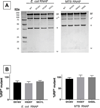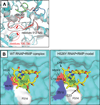Structural basis for rifamycin resistance of bacterial RNA polymerase by the three most clinically important RpoB mutations found in Mycobacterium tuberculosis
- PMID: 28009073
- PMCID: PMC5344776
- DOI: 10.1111/mmi.13606
Structural basis for rifamycin resistance of bacterial RNA polymerase by the three most clinically important RpoB mutations found in Mycobacterium tuberculosis
Abstract
Since 1967, Rifampin (RMP, a Rifamycin) has been used as a first line antibiotic treatment for tuberculosis (TB), and it remains the cornerstone of current short-term TB treatment. Increased occurrence of Rifamycin-resistant (RIFR ) TB, ∼41% of which results from the RpoB S531L mutation in RNA polymerase (RNAP), has become a growing problem worldwide. In this study, we determined the X-ray crystal structures of the Escherichia coli RNAPs containing the most clinically important S531L mutation and two other frequently observed RIFR mutants, RpoB D516V and RpoB H526Y. The structures reveal that the S531L mutation imparts subtle if any structural or functional impact on RNAP in the absence of RIF. However, upon RMP binding, the S531L mutant exhibits a disordering of the RIF binding interface, which effectively reduces the RMP affinity. In contrast, the H526Y mutation reshapes the RIF binding pocket, generating significant steric conflicts that essentially prevent any RIF binding. While the D516V mutant does not exhibit any such gross structural changes, certainly the electrostatic surface of the RIF binding pocket is dramatically changed, likely resulting in the decreased affinity for RIFs. Analysis of interactions of RMP with three common RIFR mutant RNAPs suggests that modifications to RMP may recover its efficacy against RIFR TB.
© 2016 John Wiley & Sons Ltd.
Figures






Similar articles
-
Insights into RpoB clinical mutants in mediating rifampicin resistance in Mycobacterium tuberculosis.J Mol Graph Model. 2016 Jun;67:20-32. doi: 10.1016/j.jmgm.2016.04.005. Epub 2016 Apr 23. J Mol Graph Model. 2016. PMID: 27155814
-
Rifampin-resistance-associated mutations in the rifampin-resistance-determining region of the rpoB gene of Mycobacterium tuberculosis clinical isolates in Shanghai, PR China.J Med Microbiol. 2021 Mar;70(3). doi: 10.1099/jmm.0.001317. Epub 2021 Jan 28. J Med Microbiol. 2021. PMID: 33507146
-
Rifamycin inhibition of WT and Rif-resistant Mycobacterium tuberculosis and Escherichia coli RNA polymerases in vitro.Tuberculosis (Edinb). 2011 Sep;91(5):361-9. doi: 10.1016/j.tube.2011.05.002. Epub 2011 Jun 24. Tuberculosis (Edinb). 2011. PMID: 21704562
-
Mutations inside rifampicin-resistance determining region of rpoB gene associated with rifampicin-resistance in Mycobacterium tuberculosis.J Infect Public Health. 2018 Sep-Oct;11(5):605-610. doi: 10.1016/j.jiph.2018.04.005. Epub 2018 Apr 26. J Infect Public Health. 2018. PMID: 29706316 Review.
-
Mechanisms and detection methods of Mycobacterium tuberculosis rifampicin resistance: The phenomenon of drug resistance is complex.Tuberculosis (Edinb). 2021 May;128:102083. doi: 10.1016/j.tube.2021.102083. Epub 2021 May 8. Tuberculosis (Edinb). 2021. PMID: 33975262 Review.
Cited by
-
The dormancy-specific regulator, SutA, is intrinsically disordered and modulates transcription initiation in Pseudomonas aeruginosa.Mol Microbiol. 2019 Sep;112(3):992-1009. doi: 10.1111/mmi.14337. Epub 2019 Jul 10. Mol Microbiol. 2019. PMID: 31254296 Free PMC article.
-
Bacteriophages limitedly contribute to the antimicrobial resistome of microbial communities in wastewater treatment plants.Microbiol Spectr. 2023 Sep 19;11(5):e0110123. doi: 10.1128/spectrum.01101-23. Online ahead of print. Microbiol Spectr. 2023. PMID: 37724865 Free PMC article.
-
The Core and Holoenzyme Forms of RNA Polymerase from Mycobacterium smegmatis.J Bacteriol. 2019 Jan 28;201(4):e00583-18. doi: 10.1128/JB.00583-18. Print 2019 Feb 15. J Bacteriol. 2019. PMID: 30478083 Free PMC article.
-
Genetic Characterization and Population Structure of Drug-Resistant Mycobacterium tuberculosis Isolated from Brazilian Patients Using Whole-Genome Sequencing.Antibiotics (Basel). 2024 May 28;13(6):496. doi: 10.3390/antibiotics13060496. Antibiotics (Basel). 2024. PMID: 38927163 Free PMC article.
-
Evolving MRSA: High-level β-lactam resistance in Staphylococcus aureus is associated with RNA Polymerase alterations and fine tuning of gene expression.PLoS Pathog. 2020 Jul 24;16(7):e1008672. doi: 10.1371/journal.ppat.1008672. eCollection 2020 Jul. PLoS Pathog. 2020. PMID: 32706832 Free PMC article.
References
-
- Alekshun M, Kashlev M, Schwartz I. Molecular cloning and characterization of Borrelia burgdorferi rpoB. Gene. 1997;186:227–235. - PubMed
-
- Aristoff PA, Garcia GA, Kirchhoff PD, Showalter HD. Rifamycins - Obstacles and Opportunities. Tuberculosis. 2010;90:94–118. - PubMed
-
- Artsimovitch I, Vassylyeva MN, Svetlov D, Svetlov V, Perederina A, Igarashi N, Matsugaki N, Wakatsuki S, Tahirov TH, Vassylyev DG. Allosteric modulation of the RNA polymerase catalytic reaction is an essential component of transcription control by rifamycins. Cell. 2005;122:351–363. - PubMed
MeSH terms
Substances
Grants and funding
LinkOut - more resources
Full Text Sources
Other Literature Sources

